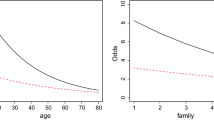Abstract
This paper is about the analysis of effects of status inconsistency and mobility on a dependent variable. We compare the mainstream square additive baseline model to alternative designs by Hope (1971, 1975) and Sobel (1981, 1985). Both writers claim that the square additive baseline model also contains some status inconsistency effects. An examination of the relationships between the square additive model, Hope's halfway/difference model, and Sobel's simple diagonal reference model shows that the effects uncovered by Sobel and Hope pertain to the inequality of the effects of the status variables on the dependent variable. These salience difference effects are therefore distinct from the non-additive status inconsistency effects which would be detected using the square additive approach. Less restricted versions of the diagonal reference model, the DM-1 and DM-2 models as well as a recent model by Weakliem (1992), are also examined with regard to additive/non-additive components and symmetry of effects.
Similar content being viewed by others
References
Alschuler, L. R. (1973). Status equilibration, reference groups, and social fields.General Systems 18: 99–118.
Blalock, H. M. (1966). The identification problem and theory building: the case of status inconsistency.American Sociological Review 31: 52–61.
Blalock, H. M. (1967). Status inconsistency and interaction: some alternative models.American Journal of Sociology 73: 305–315.
Blau, P. M. & O. T. Duncan (1967).The American Occupational Structure. New York: The Free Press.
Bock, R. D. (1975).Multivariate Statistical Methods in Behavioral Research. New York: McGraw-Hill.
De Graaf, N. D. (1991). Distinction by consumption in Czechoslovakia, Hungary, and the Netherlands.European Sociological Review 7: 267–290.
De Graaf, N. D. & A. Heath (1992). Husbands and wives' voting behaviour in Britain: Class dependent mutual influence of spouses.Acta Sociologica 35: 311–322.
De Graaf, N. D. & H. Ganzeboom (1990). Statusgroepen en cultuurdeelname. (Status group effects on culture consumption.)Mens en Maatschappij 65: 219–244.
De Graaf, N. D., P. Nieuwbeerta & A. Heath (1992). Intergenerational class mobility and political preferences in Germany, the Netherlands, Britain and the United States. Paper to be presented at the ASA meeting in Pittsburgh, 19–24 August 1992.
De Graaf, N. D. & W. Ultee (1987). Intergenerationele mobiliteit en politieke verhoudingen.Acta Politica 22: 1–37.
De Graaf, N. D. & W. C. Ultee (1990). Individual preferences, social mobility and electoral outcomes.Electoral Studies 9: 108–131.
Duncan, O. D. (1966). Methodological issues in the analysis of social mobility. In N. L. Smelser & S. M. Lipset (eds.),Social Structure and Mobility in Economic Development, Chicago, Aldine Publishing Company, pp. 51–97.
Geschwender, J. A. (1967). Continuities in theories of status inconsistency and cognitive dissonance.Social Forces 46: 160–171.
Hendrickx, J. (1992a). Using SAS macros and PROC IML to create special designs for Generalized Linear Models. In: SAS Institute,SEUGI '92. Proceedings of the SAS® European Users Group International Conference, Vienna, May 19–22, 1992, pp. 634–655.
Hendrickx, J. (1992b). Specifying link functions and error distributions for categorical models using nonlinear designs. Available on request.
Hendrickx, J. & J. Lammers (1992). Design techniques for equal/unequal main effects and symmetrical/asymmetrical interactions. In: B. Francis, G. U. H. Seeber, P. G. M. van der Heijden & W. Jansen (eds.),Statistical Modelling-6th International Workshop on Statistical Modelling, July 15–19, 1991, Utrecht, The Netherlands, Amsterdam, Elsevier, pp. 149–158.
Hope, K. (1971). Social mobility and fertility.American Sociological Review 36: 1019–1032.
Hope, K. (1975). Models for status inconsistency and social mobility effects.American Sociological Review 40: 322–343.
Hope, K. (1981). Vertical mobility in Britain: a structured analysis.Sociology 15: 19–55.
Hope, K. (1982). Vertical and nonvertical class mobility in three countries.American Sociological Review 47: 99–113.
Hope, K. (1991). Design matrix analysis.Quality and Quantity 25: 333–344.
House, J. S. (1978). Facets and flaws of Hope's diamond model.American Sociological Review 43: 439–442.
Jackson, E. F. (1962). Status consistency and symptoms of stress.American Sociological Review 27: 469–480.
Jackson, E. F. & P. J. Burke (1965). Status and symptoms of stress: additive and interaction effects.American Sociological Review 30: 556–564.
Jackson, E. F. & R. F. Curtis (1972). Effects of vertical mobility and status inconsistency: a body of negative evidence.American Sociological Review 37: 701–713.
Lenski, G. E. (1954). Status crystallization: a non-vertical dimension of social status.American Sociological Review 19: 405–413.
Lenski, G. E. (1956). Social participation and status crystallization.American Sociological Review 21: 458–464.
Slomczynski, K. M. (1989). Effects of status-inconsistency on the intellective process: The United States, Japan, and Poland. In M. L. Kohn (ed.),Cross-National Research in Sociology, London: Sage Publications, pp. 148–166.
Sobel, M. E. (1981). Diagonal mobility models: a substantively motivated class of designs for the analysis of mobility effects.American Sociological Review 46: 893–906.
Sobel, M. E. (1985). Social mobility and fertility revisited: some new models for the analysis the mobility effects hypothesis.American Sociological Review 50: 699–712.
Sobel, M. E., M. Hout & O. D. Duncan (1985). Exchange, structure, and symmetry in occupational mobility.American Journal of Sociology 91: 359–372.
Sorenson, A. M. (1989). Husbands' and wives' characteristics and fertility decisions: a diagonal mobility model.Demography 26: 125–135.
Weakliem, D. (1992). Does social mobility affect political behavior?European Sociological Review 8: 153–165.
Whitt, H. P. (1983). Status inconsistency: a body of negative evidence or a statistical artifact?Social Forces 62: 201–233.
Wilson, K. L. (1979). Status inconsistency and the Hope technique I: the grounds for a resurrection.Social Forces 57: 1229–1247.
Wilson, K. L. & L. A. Zurcher (1976). Status inconsistency and participation in social movements: an application of Goodman's hierarchical modeling.The Sociological Quarterly 17: 520–533.
Zimmerman, E. (1985). Almost everything you always wanted to know about status inconsistency (but were afraid to measure).Social Behavior and Personality 13: 193–214.
Zurcher, L. A. & K. L. Wilson (1979). Status inconsistency and the Hope technique II: a linear hypothesis about status enhancement, status detraction, and satisfaction with membership.Social Forces 57: 1248–1664.
Author information
Authors and Affiliations
Rights and permissions
About this article
Cite this article
Hendrickx, J., De Graaf, N.D., Lammers, J. et al. Models for status inconsistency and mobility: A comparison of the approaches by Hope and Sobel with the mainstream square additive model. Qual Quant 27, 335–352 (1993). https://doi.org/10.1007/BF01102497
Issue Date:
DOI: https://doi.org/10.1007/BF01102497




